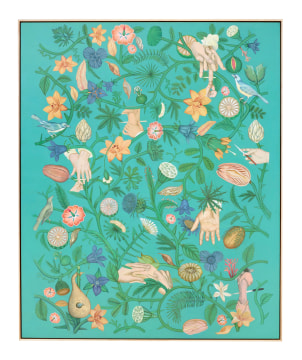
Shifting Grounds
By Maria Iovino
February 2023
In the paradises Facundo creates, the fascination aroused by the multiplicity of wonderful forms contrasts with the visions of scenes of natural, everyday life and human history that have the energy or potential to disrupt the panorama. The scenes that lead into this effervescent world are so convincing that they manage to foreclose the possibility of generating idyllic stories or quick and easy interpretations in the foreground.
With a stunning naturalness, the delicate images in Shifting Grounds, aided by a remarkable mastery of drawing, painting and miniatures, weave together what is attractive and what is undesirable, what could be called harmonious and what is evidently not, and what is artificial and what is original, as well. There are no definitive statements or judgments in these works. The dissonance within them is inalterably discovered in the subtlety of the images, in such a way that the clash with the uproar and the discrepancies occurs in the realm of the beautiful without interrupting the continuities or flow of events, thus increasing the bewildering nature of the work.
In each painting and with a serene voice, Rodrigo Facundo offers an access into the complexity of the world of which we are all a part, with all our ideological constructs, in microscopic and macroscopic proportions at the same time. Thus, in a single encounter, the artist reveals the difficulty involved in making an entirely truthful or unquestionable reading of reality, while clarifying the dominance of editing for vision, for narration and for interpretation. Each work pays tribute to nature and the ability of beings, especially humans, to create, transform and to perpetuate themselves but warns in very different ways how this happens thoughtlessly and voraciously and, at the same time, with innumerable corrosive consequences. That announcement, expressed among the proliferation of represented beauty and the evidence of the power of expression possessed by an artist who dominates artistic expression, is profoundly moving.
In Abatido (Defeated), for example, the attraction produced by the refined images in the painting does not end with the estrangement caused by the presence of the hunter with his enormous prey on his shoulder. It is obvious that the ferocious feline suffered a fatal attack, most likely the work of the man whose charm seems drawn from a fantasy tale. The empathy towards life that should not have ceased to exist and the critical vision that stems from it is prompted by the symphonic whisper of the fragile flora among the apparently peaceful hunter’s headway and the great animal’s deep sleep of no return.
Rodrigo Facundo is one of a few contemporary artists whose work merges conceptual scope with technical ability, a fact that in itself is worth mentioning. The abandonment of technique and the emphasis on the purely conceptual has gradually kept many artists, lost in philosophical and theoretical labyrinths, from understanding the realities upon which they reflect. The visual artist structures his understanding through observation and the production of images. He believes in both aspects: attention and concreteness.
In this sense, the artist’s work is related to that of the Brazilian creator Adriana Varejao. Both she and Rodrigo Facundo are admirable draftsmen and painters. Both represent a clear presence of these media in their representative work. Both update the historical image. Both energize painting in the field of sculpture and other visual media. Both are interested in the political expressions enunciated in colonial dynamics and in decolonial acts. Both have a clear ecological vocation and understand that their passion is filtered by their taste for nature and a judicious study of history, the arts and architecture, as well as ideas from different philosophical, literary and poetic traditions.
Rodrigo Facundo’s vision and training have been enriched by his interest in and persistent exploration of photography, video, and different multimedia tools, but also in crafts such as weaving, miniatures, engraving and sculpture made from iron and other materials. The concept of the image in Shifting Grounds is traversed by the knowledge of these manners of manifestation. In the universe expressed in each work present in the exhibition, culture can be seen in the different weaving techniques and the understanding of the metaphor of the cosmic order as a dynamic network structured from an infinity of stitches and knots. Likewise, the artist’s painstaking execution of each detail comes from his knowledge of photography, just as his conception of multiplicity and editing is nourished by film and video. The use of these media has contributed to the multidimensional understanding of memory in new perspectives that Rodrigo Facundo’s Shifting Grounds emphasizes.
In Shifting Grounds, nature itself becomes an expression of memory. Its communication and intertwining with cultural events modify it in such a way that nature bears witness to culture, while culture constitutes evidence of the nature it has modified and the ways it has done so.
Although Shifting Grounds shares structural strategies with other series by Rodrigo Facundo, the case could be made that this work is more comprehensive. The series carries to paradise the infinite number of actions that make it a paradise but that, at the same time, unbalance it and put it at risk.